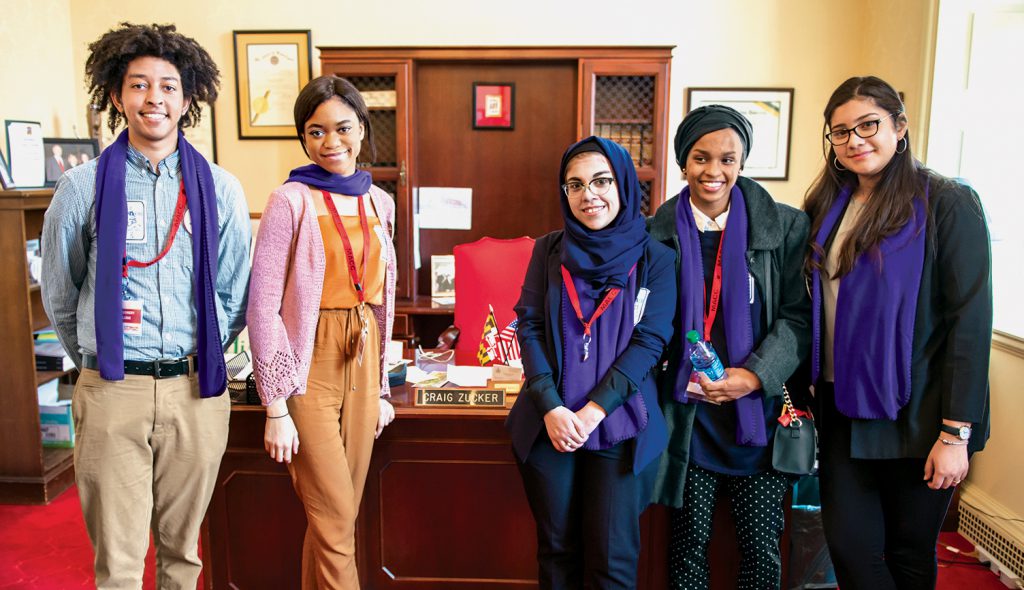Embracing Change in Demographics

Students met with state representatives in Annapolis for Advocacy Day, February 8, 2017.
“We are browner, older, and less wealthy than ever in the history of this county. How do we … ensure that those three facts are not seen as negatives, as they are in other places in this world? How do we have student support services so students understand we are here to meet them where they are and to help them graduate?” —DeRionne Pollard, “Milestone Moments: Building for Student Success”
Ask anyone in the county what they like about Montgomery College and you will hear: “great faculty,” “affordability,” and “quality courses,” among the responses. You will also likely hear mention of diversity, which is among the College’s most visible traits. Today, students who identify as nonwhite comprise 72 percent of the enrollment, compared to just 8 percent in 1975. In classrooms, students are just as likely to sit next to someone from Ghana as they are someone from Gaithersburg.
The demographics on campus reflect Montgomery County’s changing population. The US Census Bureau reports that nearly a third of today’s residents are foreign-born (32.6 percent), and almost 40 percent (39.6%) of residents speak a language other than English at home.1 In 2012, county officials projected a 10-year increase in nonwhite populations as follows: Hispanic (20 percent), Asian (13 percent), and African American (7 percent).
“We invest a lot of resources in diversity and inclusion,” says MC President DeRionne Pollard. “This last term is important: inclusion goes beyond tolerance. It means everyone belongs here, and we will make them feel welcomed. And how do we help them succeed?”
While an open-access admission policy assures higher education for anyone with a diploma or GED credential, maintaining it has resulted in an increased number of students considered “academically vulnerable,” or underprepared to succeed at the college level. Students take an assessment test after enrollment to determine their placement in math and English courses. On average, 72 percent of entering first-time students need at least one developmental class (slightly above the 68 percent national average for community college students). One in five MC students enrolls in a developmental math course; nearly 54 percent of math classes offered now are developmental.
To meet its mission of student success, the College has increased programs, support services, and staffing for these students. Pollard’s signature program, ACES (Achieving Collegiate Excellence and Success), for example, targets students in county high schools who are most often underrepresented in college, and students who are first in their family to attend college. The program launched in July 2012, and the first ACES students graduated MC in 2016; all 16 transferred to four-year institutions.
“These are students who many people would call ‘at risk’—largely students of color, poor, and most of whom do not have a parent who went to college themselves,” says Pollard.
ACES students receive extra academic support, financial assistance, and a host of other mentoring tools using a case management approach while students are still high school. ACES has coaches (MC staff) at 10 MCPS schools, with 1,700 students enrolled currently. Students who choose to attend MC and then USG continue to receive support via on-campus academic coaches.
“That’s what it comes down to in the end,” says Pollard, “to feel like one matters and is included in a community. When students feel this way, and they are supported, then they achieve. If this is a radical idea, then so be it. People are included and they thrive: that’s radical inclusion from where I sit.”
The College has concentrated on accommodating academically vulnerable students at the same time the state implemented measures (via the College and Career Readiness and College Completion Act, 2013) to increase college completion in Maryland by 2025. With implications that future funding may be tied to performance, status quo is not an option.
Right now, the average MC student takes 4.5 years to complete a two-year degree program. Reasons students fail to progress more quickly at MC are many and varied. Those without clear academic interests or goals can become distracted by courses that do not align with degree or certificate requirements.
Students who must repeat remedial courses—in mathematics and English—sometimes become discouraged. Students who lack the skills to plan for six years of part-time study while working full time are often at risk of falling behind. Others face financial obstacles. The College has seen an 80 percent increase in students applying for financial aid since 2015.
Efforts to improve graduation and transfer rates under Pollard’s leadership have run the gamut from a collegewide restructuring to streamline operations and make popular programs available to students at all three campuses, to instituting new programs for students in under-performing populations, including some for students before they ever enroll at MC. Currently, there are 31 academic initiatives in the MC and MCPS partnership designed to help prepare students for a smooth transition to postsecondary education.
Revising the General Studies curriculum, in which approximately 12,000 declare their major each year—has shown results in student retention. By requiring students to choose one of four “core” areas they wish to follow, the College encourages students to put themselves on a path to success. When students see a path from the outset, they save time and money. “We’re using it as a model for moving students more effectively through other disciplines,” says Pollard.
Technology has been another tool in improving student progress. In 2013, the College acquired the Starfish retention program, which allows students to make appointments online with instructors, counselors, and advisors, and to view and follow academic plans more easily.
Online courses are increasingly giving students flexible scheduling options, considering many MC students juggle work and family obligations while attending college. Four degrees can be completed fully online now: general studies, business, computer science and technologies (two tracks: computer science and information systems), and criminal justice. “Online education is no longer an experiment in pedagogy,” says Pollard. “Twenty-two percent of MC students took a course online last year.”
Technology has also reduced the need for expensive textbooks; nationwide, the average book now costs $180 and students typically must spend $1,200 on books and supplies each year.3 Through the use of Online Education Resources (OERs) and the MC Open initiative, faculty are rewriting courses to eliminate cost-prohibitive course materials.
By removing—or at least lowering—barriers that exist for students striving to “achieve the promise” of higher education, the College can better meet accountability standards imposed by public policy and the community at large.
It can also continue to brag about its diversity—160 nations represented at MC—in terms of what it contributes to cultural competence.
Diversity provides opportunities to interact effectively with people of different cultures and socioeconomic backgrounds, which in itself has become an important skill set for navigating an increasingly multiethnic, multinational, and globally interdependent world. Financially, closing achievement gaps is critical to the state and county’s economic viability. Based on the county’s projections for sustained increases in multicultural populations, the College foresees ongoing need for special programs that support students inside and outside the classroom.
“We have to be more responsive to our students’ complex lives,” says Pollard. “This is the reality of the population of students we serve. It’s also a market reality: we have to be competitive, and this is becoming the industry standard.”
Who Are the Academically Vulnerable Students? 2
First-generation college student
From underrepresented minorities
Financial limitations—cannot afford books
Poor high school academic preparation
No family guidance to help him or her navigate the academic world
Has job responsibilities
Has child care responsibilities
From low-income family
Involved in hours of commuting
Distracted by transportation difficulties
“Montgomery College will always be a safe and open institution.”
Prompted by policy actions at the federal level and concerns for some on the College’s campuses, the Montgomery College Board of Trustees met in February and issued a statement to confirm the College’s commitment to what President DeRionne Pollard calls “radical inclusivity.”
“Discrimination against people of color, international or undocumented students, and students of any specific religious tradition have no place in a civil society or in our learning environments. We will continue to craft policies and practices that combat intimidation, harassment, and hate crimes, and to nurture a culture that condemns such affronts.”
The official statement reflects the national debate about immigration and policies regarding law enforcement for undocumented immigrants. In Maryland, Montgom-ery County, Prince George’s County, and Baltimore City are listed as sanctuary jurisdictions by the Center for Immigration Studies.
Montgomery County has maintained sanctuary policies without officially declaring itself a sanctuary county, or self-designated safe zone for undocumented immigrants.
According to the College’s Office of Institutional Research and Analysis, the top countries represented among MC’s international students are: Cameroon, Peru, Ghana (Germantown Campus); Cameroon, Ethiopia, El Salvador (Rockville Campus); and Ethiopia, Cameroon, El Salvador (Takoma Park/Silver Spring). [“Distribution by Campus of International Students, Fall 2015”]. Collegewide, 28 percent of credit students are international students.
Sources:
1 Montgomery County census data (2011–2015)
2 MC Office of Institutional Research and Analysis report, “Underprepared Students: Their Progression to College Level Courses, Bailey, Jaggars, and Jenkins: “Introduction to the CCRC Assessment of Evidence Series” Community College Research Center, Columbia College, January 2011
3 bigfuture.collegeboard.org/pay-for-college/college-costs/quick-guide-college-costs
Photography by Pete Vidal


